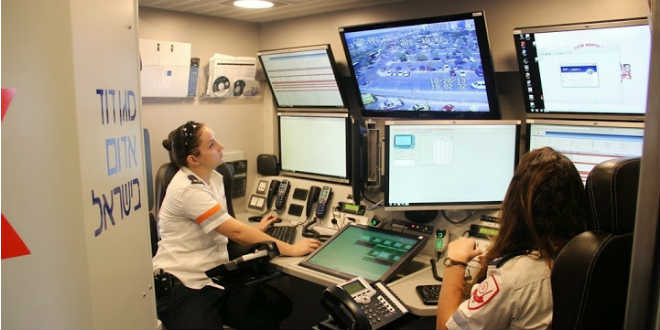“Heal me, O LORD, and I shall be healed; save me, and I shall be saved; for Thou art my praise.” (Jeremiah 17:15)

Israel’s Red Cross affiliate, Magen David Adom (MDA), unveiled a multi-million-dollar mobile command center this week. The truck is designed to direct rescue operations in difficult terrain and under complex circumstances, including cellular service failure.
The construction of the vehicle was motivated by the 2010 Carmel Forest fire, during which 44 people died. Rescue services were complicated by communication failures; cellular service was alternately too weak or overwhelmed by calls. “It was what made us think about the future,” MDA special projects manager Assi Dvilanski said. Dvilanski supervised the truck’s construction, and said it was the most technologically advanced vehicle of its kind in the world.
The truck, officially called the “National Mobile Command and Control Vehicle,” was unveiled at an event at Tel Aviv’s Old Train Station. It was designed and constructed specifically for MDA. It was assembled in England on a Dutch-manufactured DAF truck frame. It is 16 meters (52.5 ft) long, 4 meters (13 ft) wide, and weighs 32 tons. It boasts over two dozen flat screen monitors displaying information on all ambulances across Israel to as many as five dispatchers at a time. Its nerve center allows a single dispatcher to control six different monitors and use nine different phones and radios, all connected directly to police and rescue services. It also has a camera mounted on a mast which can reach heights of 19 meters (over 62 ft) to assist in coordinating rescue workers over a large area. The camera feed can be controlled and viewed from any commander’s smartphone.
Still, its most important features are not visible. It has the ability to access all three major national cellular networks and combine their signals to boost signal strength. It also has satellite phones for times when both cellular and traditional land service are unavailable. Most unique, however, is that the truck can hook directly into Israel’s 101 emergency call service, the equivalent of 911 in North America, which allows the truck to serve as a twelfth dispatch center for MDA or as a full backup, in case one of MDA’s centers goes down. According to Dvilanski, it is the only mobile center in Israel, and to his knowledge, the world, with this capability.
Despite its size, the command center takes only 20 minutes to set up or pack up. This is useful in many emergency situations, as it allows rescuers to respond quickly to changes in circumstances, such as a fast-moving fire. The truck will be useful in a variety of situations, from fires to earthquakes to train derailments to the aftermath of war. In such cases, “we will still be able to have all the emergency calls come into the vehicle,” Dvilanski said.
At Sunday’s dedication ceremony, MDA also revealed another unique rescue vehicle, this one assembled for MDA by Chevrolet. The specially-equipped Suburban is designed to tackle especially difficult terrain, allowing rescuers to save lives in areas ordinarily beyond the access of traditional emergency vehicles. It carries all the necessary medical equipment and can transport two paramedics, one patient in a stretcher and two additional, seated passengers.




